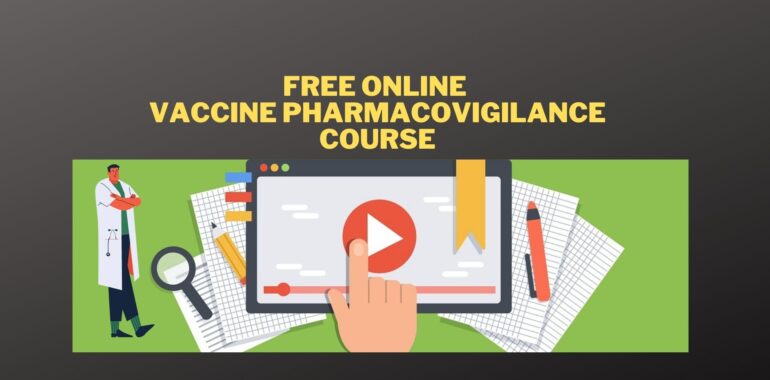Free Online Vaccine Pharmacovigilance Course

Free Online Vaccine Pharmacovigilance Course
Here we are going to give the best Free Online Vaccine Pharmacovigilance Course details.
Vaccine Pharmacovigilance is defined as the science and activities relating to the
- Detection,
- Assessment,
- Understanding and
- Communication of adverse events following immunization and other vaccine- or immunization-related issues,
and to the prevention of untoward effects of the vaccine or immunization
As with drug pharmacovigilance, Vaccine Pharmacovigilance is designed to detect adverse events early to trigger an accurate risk assessment and appropriate (risk management) response to the problem.
Do you know, WHO is offering Free Online Vaccine Pharmacovigilance Course.
Free Online Vaccine Pharmacovigilance Course. Access the course
The purpose of this course is to develop a common understanding among professionals whose work is related to vaccine safety issues.
These may include nurses, midwives, community health workers, pharmacists, physicians, program officials or technicians.
This course consists of six modules.
MODULE 1: Introduction to vaccine safety
MODULE 2: Types of vaccine and adverse reactions
MODULE 3: Adverse events following immunization
MODULE 4: Surveillance
MODULE 5: Vaccine safety institutions and mechanisms
MODULE 6: Communication

Each module takes 1 ½ hours to complete. Additionally, this course contains Case studies, Assessments and Supplementary tools.
Each Module covers the following topics.
MODULE 1: Introduction to vaccine safety
- Overview
- Importance of immunization programmes
- History of vaccine development
- Expectations towards safety of vaccines
- How the immune system works
- How vaccines work
- Vaccine-preventable diseases
- Types of vaccine
- Adverse events
- Classification
- Causes
- Frequency and severity
- Vaccine safety in immunization programmes
- Vaccine regulations
- Pre-licensure vaccine safety
- Post licensure surveillance options
- Balancing efficacy and safety
- Summary
- ASSESSMENT 1
MODULE 2: Types of vaccine and adverse reactions
- Overview
- Types of vaccine
- Live attenuated vaccines
- Inactivated whole-cell vaccines
- Subunit vaccines
- Toxoid vaccines
- Combination vaccines
- Components of a vaccine
- Route of administration
- Contraindications
- Anaphylaxis
- Immunizing the immunocompromised
- Immunization and pregnancy
- Influenza
- Tetanus
- Vaccination associations and public concern
- Summary
- ASSESSMENT 2
MODULE 3: Adverse events following immunization
- Overview
- Classification of AEFIs
- Vaccine reactions
- Immunization error-related reaction
- Immunization anxiety-related reactions
- Coincidental events
- Mass vaccination campaigns
- Rates of adverse vaccine reactions
- Summary
- ASSESSMENT 3
MODULE 4: Surveillance
- Overview
- Pharmacovigilance
- NRA’s role in the regulation of drug safety
- Adverse Drug Reaction (ADR) surveillance
- Immunization safety requires a modified surveillance system
- Vaccine pharmacovigilance
- Special considerations for AEFI surveillance
- Interactions between AEFI and ADR surveillance systems
- AEFI surveillance components
- Detection and reporting
- Investigation
- Causality assessment of AEFIs
- Risk/benefit assessment
- Summary
- ASSESSMENT 4
MODULE 5: Vaccine safety institutions and mechanisms
- Overview
- Overview of functions
NATIONAL LEVEL
- National AEFI surveillance systems
- National regulatory authority
- Core functions specific to vaccines
- Functions depending on the source of vaccines
- Vaccine procurement and lot release
- Regulation of drug safety
- National immunization programmes (NIP)
- Core functions specific to vaccine safety
- Safety of vaccine administration
- AEFI Review Committee
- Other support groups
INTERNATIONAL LEVEL
- Global vaccine safety stakeholders and services
- Global analysis and response
- Global Advisory Committee on Vaccine Safety (GACVS
- Good information practices – Vaccine Safety Net
- Global Capacity building and harmonized tools
- Brighton Collaboration – setting standards in vaccine safety
- CIOMS/WHO working group
- Vaccine safety training opportunities
- Global signal evaluation and detection
- WHO Programme for International Drug Monitoring
- Global Vaccine Safety DataNet (GVSD)
- Product monitoring
- Global Vaccine Safety Initiative
- Summary
- ASSESSMENT 5
MODULE 6: Communication
- Overview
- Risk communication
- Need for improved communication
- Communicate only reliable information
- Simplified and key messages
- Risk perception
- Sources of information
- Communicating in public
- Responding to vaccine safety crises
- Rumours and crises
- Impact of rumours and crises
- Responding to rumours and crises
- Communicating with the media
- Preparing a press release
- Preparing for an interview
- Summary
The content of this course has been compiled by leading international vaccine experts who are committed to promoting best practices in implementing immunization programs around the world.
Do want to access the Free Online Vaccine Pharmacovigilance Course? Click here
Do you want to know more about Free Online Pharmacovigilance courses? Click here
Source from WHO website.